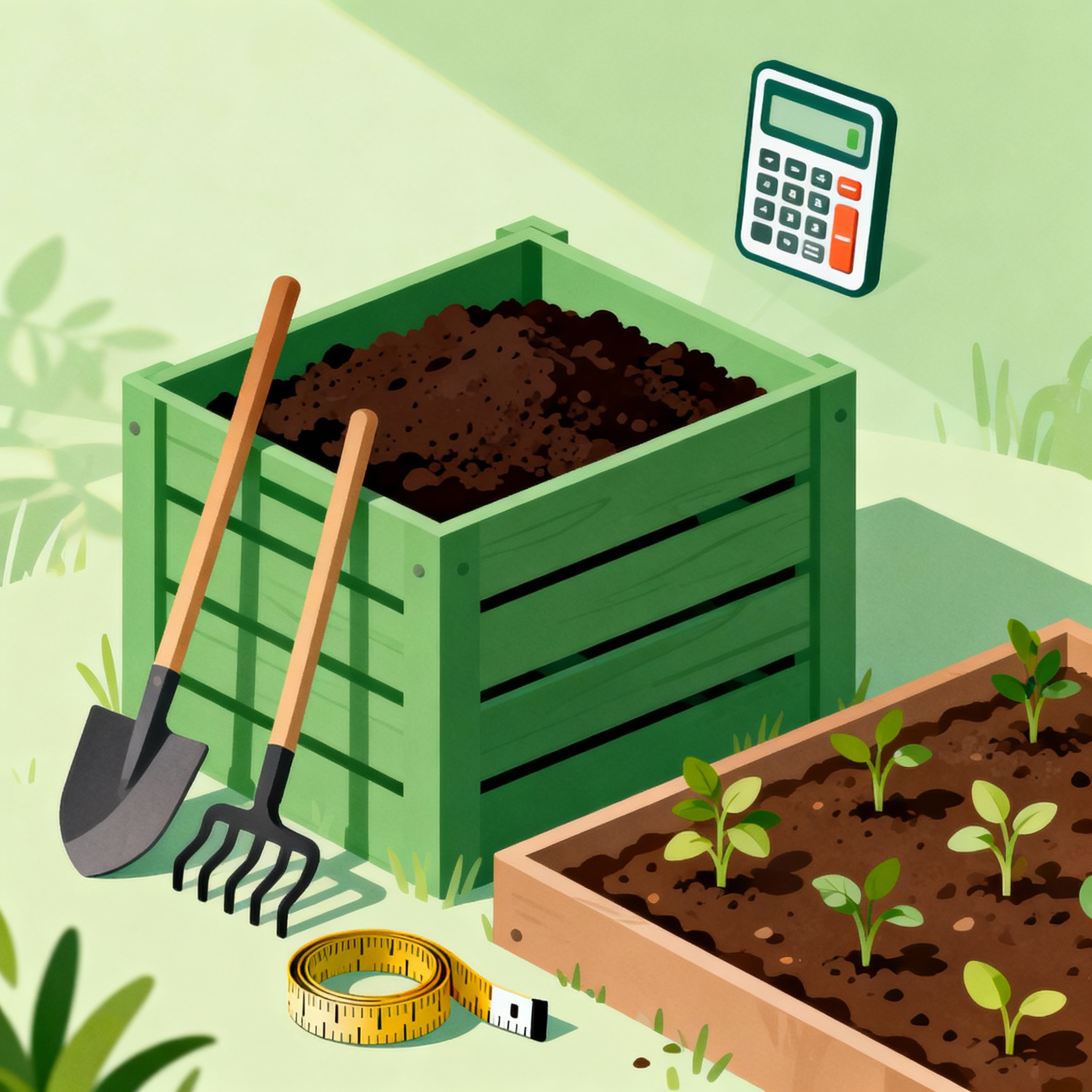Basic Compost Calculator
Advanced Compost Calculator
Benefits of Compost
🌱 Soil Health
- Improves soil structure and aeration
- Enhances water retention
- Increases beneficial microorganisms
- Balances soil pH naturally
💪 Plant Growth
- Provides essential nutrients
- Promotes stronger root systems
- Increases disease resistance
- Boosts plant productivity
♻️ Environmental
- Reduces landfill waste
- Lowers carbon footprint
- Decreases chemical fertilizer need
- Conserves water usage
💰 Cost Savings
- Free fertilizer from kitchen scraps
- Reduces need for store-bought soil
- Lowers water bills
- Decreases pest control costs
🛠️ How to Make Compost
What to Compost (Greens – Nitrogen-rich):
- Fruit and vegetable scraps
- Coffee grounds and tea bags
- Fresh grass clippings
- Plant trimmings
What to Compost (Browns – Carbon-rich):
- Dry leaves
- Shredded newspaper and cardboard
- Sawdust and wood chips
- Straw and hay
What NOT to Compost:
- Meat, fish, dairy products
- Pet waste
- Diseased plants
- Treated wood or sawdust
Basic Steps:
- Layer materials: Alternate green and brown materials in roughly 1:2 ratio
- Add water: Keep as moist as a wrung-out sponge
- Turn regularly: Every 1-2 weeks for faster decomposition
- Wait: Compost is ready in 2-6 months when dark and crumbly
- Use: Mix into soil or use as top dressing
Compost Calculator User Guide
What It Does:
This calculator helps you determine the exact amount of compost needed for your garden, lawn, raised beds, or any gardening project, ensuring you buy just the right amount without waste.
How to Use:
📐 Basic Calculator
Use this for simple rectangular areas like gardens or raised beds.
- Enter Dimensions:
- Length – Enter the length of your garden area in feet
- Width – Enter the width of your garden area in feet
- Depth – Enter desired compost layer thickness in inches
- Recommended: 2-3 inches for gardens, 0.5 inch for lawns
- Calculate:
- Click “Calculate Compost” button
- Results show total compost needed in:
- Square feet (area coverage)
- Cubic feet (volume)
- Cubic yards (for bulk ordering)
- Number of 2 cu ft bags needed
- Review Tips:
- Application tips appear below results
- Follow recommendations for best results
- Start Over:
- Click “Reset” to clear all fields
⚙️ Advanced Calculator
Use this for circular gardens, custom shapes, or when mixing compost with soil.
- Select Area Type:
- Rectangular/Square – Standard gardens
- Circular – Round flower beds or tree rings
- Custom Area – Irregular shapes (enter total square footage)
- Enter Measurements:
- For rectangular: Enter length and width
- For circular: Enter diameter
- For custom: Enter total area in square feet
- Set Compost Depth:
- Enter desired thickness in inches
- Choose Mix Ratio:
- 100% – Pure compost layer (top dressing)
- 50% – Heavy mix (1:1 compost to soil)
- 33% – Standard mix (1:2 compost to soil)
- 25% – Light mix (1:3 compost to soil) Recommended for most gardens
- Calculate & Review:
- Click “Calculate Compost”
- If mixing with soil, calculator shows both compost and soil amounts needed
- Follow mixing instructions provided
💡 Benefits & Making
Educational reference on composting benefits and DIY composting guide.
What’s Included:
- Benefits sections covering soil health, plant growth, environmental impact, and cost savings
- How to make compost with step-by-step instructions
- What to compost (greens and browns list)
- What NOT to compost (safety guidelines)
- Composting process timeline and maintenance tips
Quick Tips:
✅ For new garden beds: Use 2-3 inch depth
✅ For existing lawns: Use 0.25-0.5 inch depth
✅ For potting mix: Use 25-33% compost ratio
✅ For raised beds: Mix 25-50% compost with soil
Pro Tip: Buy compost in bulk (cubic yards) for large projects to save money, or use bagged compost for small areas and precise application.

Angelina Everly leads the editorial desk at Live Green Gardens, blending practical plant care, hands-on product testing, and approachable outdoor styling. She focuses on step-by-step how-tos, buyer’s guides, and small-space makeovers that work in real life and real budgets. When she’s not comparing pruning shears or setting up a drip kit, you’ll find her creating cozy corners with planters, solar lights, and pollinator-friendly picks—always with clear pros/cons and safety notes so you can buy once and garden happy.

